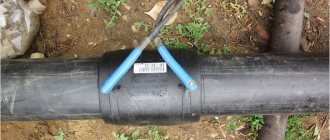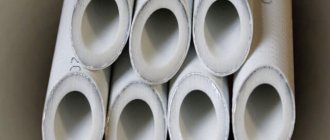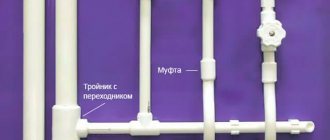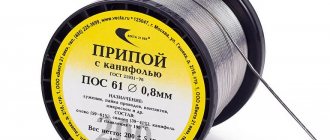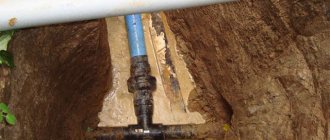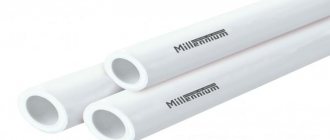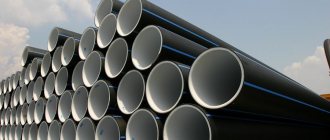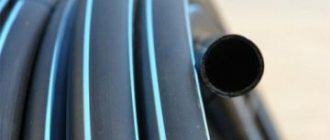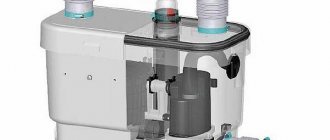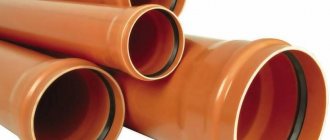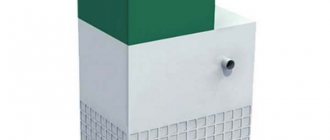They are installed in residential buildings and industrial buildings. Unlike options made of steel and cast iron, such materials are not destroyed by rust, and they can last more than 50 years.
Areas of application:
- Their distinctive characteristics and ease of installation make it possible to use them in the network for supplying drinking water.
- In agriculture.
- Pipes and fittings of this type are used for supplying cold and hot water, for installing “warm floors”, for branches in a centralized heating system, and for connecting radiators.
- Transportation of air and aggressive chemical media.
- For drainage and irrigation systems.
- This workpiece tolerates temperatures from -10 to 900C. And will withstand short-term surges up to 1100C.
- The melting point is +1490C.
- Thermal conductivity at 20 degrees – 0.24 W/mS.
IMPORTANT! Polypropylene pipes (the characteristics of experts confirm this) are classified as environmentally friendly substances; they are completely safe for technological use.
Features of marking polypropylene pipes
In order to correctly select the types and characteristics of PP pipes, you need to pay attention to their markings. First of all, you need to pay attention to the designations that characterize the operating pressure and temperature of pipe products. The standardization system in force today classifies polypropylene pipes into 4 groups:
- PN10 - polypropylene pipes designed for an operating pressure of 10 atmospheres and an operating temperature of up to +45 °C. Such products have thin walls and can only be used for transporting cold liquids;
- PN16 - PP pipes, designed for operating pressure up to 16 atmospheres and operating temperature up to +60 °C. Not intended for hot water supply and heating systems;
- PN20 - polypropylene pipes designed for operating pressure up to 20 atmospheres and operating temperature up to 95 °C. They can be used in heating and hot water supply systems, however, due to significant temperature deformation, their use in these systems is limited;
- PN25 - polypropylene pipes designed for operating pressure up to 25 atmospheres and operating temperature up to 95 °C. Polypropylene pipes PN 25 are available in reinforced versions. A layer of aluminum foil or fiberglass serves as a reinforcing element. The use of an additional reinforcing layer significantly increases the strength characteristics and reduces thermal deformation. Thanks to this, reinforced pipes for heating and hot water supply are optimally suited.
Popular manufacturers
Brands of pipes and fittings popular today on the Russian market:
- Valtec (Italy) presents three categories of polypropylene pipes: thin-walled, foil-reinforced (99.4% aluminum), fiberglass-reinforced. Material – PP-R 100. The layers are glued with adhesive compositions made in Japan and America, providing a layer strength of 70 N per 10 mm (standard – 15). During the welding process, a bead of straightened plastic does not form. A special feature of the fittings is a conical socket. Parts with metal threads are octagonal (due to their shape, they can be worked with standard keys).
- Banninger (Germany). The raw material is chemically neutral polypropylene random copolymer. The products can also be used to supply drinking water. The main disadvantage of the brand is the high price.
- Wavin Ecoplastic (Czech Republic). The pipes can withstand loads of up to 20 atm. Types of heating pipes: Stabi - foil reinforced, Fiber, Basalt+ - basalt fiber. The remaining models are suitable for cold water supply.
- Kalde (Türkiye). Types: pure polypropylene – PN10 and 16; glass fiber reinforced – PN16; superpipe – reinforced with perforated aluminum foil. The latter type does not require stripping and facing when welding. Service life at temperatures up to 70 degrees is 50 years.
- Tebo (Türkiye). The raw material is a durable polymer of the new generation Random Copolymer (PPR of the third type). Products have certificates for compliance with DIN, GOST, TSE standards. Section sizes are from 2 to 16 cm, types of pipes are PN10, 20 and 25. The foil in PN25 is non-perforated; stripping is required during welding.
- SPK (Türkiye). Polypropylene pipes are on average half the price of European brands, while maintaining high quality. Manufactured from Dutch raw materials using German equipment. Excellent characteristics: the products can also be used in difficult operating conditions (for example, in Siberia).
Advantages and disadvantages of polypropylene pipes
When installing heating systems, the question often arises which pipes are better: polypropylene, metal-plastic or metal. To decide on this issue, it is important to take into account all the advantages and disadvantages, as well as the characteristics of polypropylene pipes.
The main advantages of reinforced polypropylene pipes are their following features:
high durability. When used as part of heating systems, the service life reaches 50 years;- The smooth surface of the pipes prevents the formation of deposits. Thanks to this, the original bore diameter of the pipeline is maintained throughout its service life;
- high level of sound insulation. Even with significant pressure, the polypropylene pipe does not emit noise from the transported liquid;
- the low thermal conductivity of the material significantly reduces heat loss and prevents the formation of condensation, and also significantly reduces the risk of water freezing in the pipeline in winter;
- light weight. Polypropylene pipes weigh 9 times less compared to metal ones;
- high degree of chemical resistance, no corrosion;
- simplicity and high speed of installation, provided it is carried out professionally;
- no need for painting or additional maintenance during operation;
- favorable price of PPR pipes reinforced with glass fiber.
It is also necessary to consider the disadvantages characteristic of pipes made of this material. The main disadvantage for heating systems is, of course, the high value of the linear expansion coefficient. This can lead to deformation of the pipelines and their release from the fastenings, which is often accompanied by depressurization at the joints and causes leaks. In this regard, it is recommended to use reinforced PP pipes, whose coefficient of thermal expansion is significantly lower. However, reinforcement does not completely eliminate temperature deformation, so the installation technology involves installing fastening points and compensators at certain intervals.
Another disadvantage is that polypropylene pipes are not subject to deformation during installation. Therefore, special fittings must be used to make turns. In addition, when performing installation work and placing pipelines, it is important to take into account the negative effects of solar radiation, which can cause accelerated aging of the material.
In general, we can say that the ratio of advantages and disadvantages of polypropylene pipes determines their high efficiency when used as part of heating systems, as well as in other utility networks.
What parameters need to be considered when purchasing
Let us consider in more detail the individual technical characteristics of polypropylene pipes that influence their choice when used in water supply and heating systems.
Length
Pipes are most often produced in the form of straight sections (2, 4 or 5 meters in length), which ensures their ease of transportation and storage. If you need a custom product length, this parameter can be agreed upon during ordering.
Diameter
Dimensions of polypropylene pipes
All pipes have standardized dimensions of outer and inner diameters, which are measured in millimeters.
The outer diameter can vary within the following limits: from 16 mm to 500 mm or more.
The inner diameter can be measured in inches. Based on this indicator, the required pipe is selected based on the calculation of the required water flow, operating temperature and permissible pressure. It is also used to select connecting elements and other fittings for pipeline installation.
Depending on the size of the outer diameter, products can be divided into three main categories.
1. Small pipes (16-63 mm) are used in water supply and heating systems of private and apartment buildings, for premises for various purposes, as well as for connecting pipelines to central heating networks.
2. The middle category (75-135 mm) is used in sewer and ventilation systems of residential buildings and other buildings, as well as for transporting compressed air and various chemicals. The most popular size in this group is the diameter of 110 mm - for installation of internal sewerage systems of various buildings.
3. Pipes with large diameters (over 400 mm) are suitable for main water supply networks and external sewerage, as well as in industrial production. Products of this size are practically not used for domestic needs.
Most popular sizes
Heating system
In the context of their purpose:
- 20 mm – for indoor plumbing and installation of heating systems.
- 25 mm - for risers in low-rise buildings, wiring across floors, connecting heating radiators and installing underfloor heating systems.
- 32 mm – for risers and supply pipes in high-rise apartment buildings (from 5 floors and above).
Melting temperature
Information about what temperature polypropylene pipes can withstand is not a priority, since conventional heating systems are not designed for high coolant temperatures.
The maximum operating temperature for PN20 and PN25 pipes is 95°C. In this case, the pipes can withstand a short-term increase in temperature up to 110-120°C. When the temperature rises to 140°C, the products begin to soften and lose their shape, and when they reach 175°C, they simply melt, which leads to their complete destruction.
Thermal expansion coefficient
Formula for calculating the coefficient of linear expansion
This indicator characterizes the size of the linear expansion of a polypropylene pipe when it is heated. The physical quantity is calculated using the formula:
- unreinforced PP pipes have an expansion coefficient of 0.15
- for reinforced pipes it is 0.03
This means that with an increase in temperature from 20°C to 90°C, the length of one meter of an unreinforced pipe increases by approximately 12 - 15 mm, and of a reinforced one - by 2.5 - 3 mm.
Thus, with a length of a linear pipeline section of 5 meters and its heating to 90°C, the length can increase by 60 - 75 mm or 12.5 - 15 mm, respectively.
Such thermal expansion in rigidly fixed areas causes significant longitudinal stress in the pipe walls.
This creates additional stress on the fasteners and can cause pipe deformation, delamination or rupture. Therefore, the pipeline must be secured with movable and fixed supports in such a way that it can freely increase or decrease its length.
U-shaped compensator
On long straight sections of the pipeline (over 5 - 6 meters), to ensure linear movement of pipes, special compensators are installed in the form of turns or U-shaped bends.
READ ALSO: Choosing a soldering iron for welding polypropylene pipes, learning how to work with it
When installing pipelines, it is imperative to ensure the required gap between the wall and the pipes, especially in the places where they turn and in the corners of the room.
When designing a heating or hot water supply system, it is necessary to choose the most optimal configuration and mounting locations for pipelines, taking into account the increase in its length when hot water is supplied to the pipes.
This will ensure reliable operation and long service life of the system.
Life time
According to manufacturers, the service life of their products can be more than 50 years for hot water and up to 100 years for cold water .
However, such a long period is possible only if the normal operating conditions of polypropylene pipes are observed, which mainly depend on the operating temperature and internal pressure in the pipeline.
It should be taken into account that these parameters have an inverse relationship: the lower the temperature, the higher the pressure in the pipe can be, and vice versa.
The optimal ratio for heating systems made of polypropylene pipes is considered to be a coolant temperature of no more than 70°C at a nominal pressure of 4-6 kgf/sq.cm. When temperature and pressure increase simultaneously, the service life of products can be significantly reduced.
Calculation table with approximate service life
To calculate the approximate service life of polypropylene pipes, special formulas, diagrams and tables are used. This is a simplified table where the main criteria for the “life” of pipes are temperature and operating pressure.
| Operating fluid temperature (°C) | Type of PP pipe | Service life (in years) | |||
| PN10 | PN16 | PN20 | PN25 | ||
| Max working pressure (kgf/sq.cm) | |||||
| 30 | 7,7 | 12,2 | 15,3 | 15,3 | 1 |
| 7,2 | 11,5 | 14,3 | 14,3 | 5 | |
| 6,8 | 10,9 | 13,8 | 13,8 | 10 | |
| 6,7 | 10,6 | 13,4 | 13,4 | 25 | |
| 6,5 | 10,4 | 13,1 | 13,1 | 50 | |
| 40 | 6,5 | 10,4 | 12,9 | 12,9 | 1 |
| 6,1 | 9,7 | 12,1 | 12,1 | 5 | |
| 5,9 | 9,4 | 11,8 | 11,8 | 10 | |
| 5,6 | 9,0 | 11,3 | 11,3 | 25 | |
| 5,5 | 8,8 | 10,9 | 10,9 | 50 | |
| 50 | 5,5 | 8,6 | 10,8 | 10,9 | 1 |
| 5,1 | 8,2 | 10,2 | 10,2 | 5 | |
| 4,9 | 7,9 | 9,8 | 9,9 | 10 | |
| 4,8 | 7,5 | 9,5 | 9,6 | 25 | |
| 4,6 | 7,3 | 9,1 | 9,2 | 50 | |
| 60 | — | — | 9,2 | 9,2 | 1 |
| — | — | 8,5 | 8,5 | 5 | |
| — | — | 8,2 | 8,3 | 10 | |
| — | — | 7,9 | 7,9 | 25 | |
| — | — | 7,6 | 7,6 | 50 | |
| 70 | — | — | 7,8 | 7,9 | 1 |
| — | — | 7,2 | 7,1 | 5 | |
| — | — | 7,0 | 7,0 | 10 | |
| — | — | 6,1 | 6,2 | 25 | |
| — | — | 5,1 | 5,2 | 50 | |
| 80 | — | — | 6,5 | 6,5 | 1 |
| — | — | 5,7 | 5,8 | 5 | |
| — | — | 4,7 | 4,8 | 10 | |
| — | — | 3,0 | 3,8 | 25 | |
| 95 | — | — | 4,5 | 4,6 | 1 |
| — | — | 3,0 | 3,0 | 5 | |
It should be taken into account that this table indicates the operating period of the products under the condition of their continuous operation, therefore, when making your calculations, also take into account the duration of the annual heating season .
Calculation example
Let's consider a specific example of an approximate calculation of the service life of a PN25 pipe in a heating system with an operating coolant temperature of 70°C and a nominal pressure of 6 kgf/sq.m.
Let us assume that the annual heating season lasts seven months.
Using the table, we determine the initial figure - 25 years. Taking into account the duration of the heating season of 7 months, the final service life will be approximately 43 years (25*12/7=42.85).
Features of choosing polypropylene pipes
When choosing polypropylene pipes, four main parameters must be taken into account:
- maximum operating temperature;
- maximum working pressure;
- diameter;
- linear expansion coefficient.
The values of these parameters must be correlated with the purpose and operating conditions of the pipelines being installed.
The maximum operating temperature determines the possibility of using pipes of a certain brand to complete engineering systems for a specific purpose. Thus, pipes PN10 and PN16 can only be used for transporting cold water. PN20 products can be used for hot water supply systems, while PN25 pipes are best suited for heating.
For domestic systems, pipes with almost any operating pressure can be used. However, the value of this parameter, especially in combination with temperature, directly determines the service life of the products. That is why, for operation as part of a heating system, it is necessary to select pipes designed for the highest operating pressure.
The diameter of a polypropylene pipe determines its throughput, which makes it possible to use it in certain conditions. For example, a 32 mm or 40 mm polypropylene pipe is used for installing risers. Internal wiring is used using a 20 mm polypropylene pipe. 25 mm polypropylene pipes can also be used for the same purpose.
The coefficient of linear expansion is an important parameter that determines the degree of change in the geometry of the product under the influence of high temperature. Depending on this coefficient, the possibility of using pipes for heating or hot water supply, as well as the method of their installation, is determined. Thus, PN20 pipes have a higher coefficient of linear expansion, so they are not allowed to be laid in a closed way. Deformation of the pipe when heated can lead to destruction of the plaster. With the open installation method, more frequent installation of fasteners and compensators is required. Reinforced polypropylene pipes PN25 have a much lower coefficient of linear expansion, which allows them to be installed both inside and outside walls.
Marking of plastic pipes
Almost every polymer pipe has markings on the surface shell that reflect its dimensional, basic physical and chemical parameters. When applying it, they are often guided by the international standard ISO/TC SC4 No. 651, which regulates the following alphanumeric designations of thermoplastic pipes and their sequence:
- Symbols indicating the documentation on the basis of which the product was certified according to the EN ISO 9001 standard or another, according to which the product was released.
- Trademark (trademark, brand) of the product manufacturer.
- Information about whether the manufacturer has a certificate for the manufacture of products that meet the standards of their country or global requirements.
- Number of the domestic (GOST) or European standard according to which the product is manufactured. For example, the symbols of DIN EN ISO 12162 correspond to the standard for thermoplastics used in the laying of pressure pipelines. The act regulates the classification, designations and strength properties of pipes and shaped elements.
Rice. 5 Examples of deciphering the markings of multilayer and CPVC pipes - The letter designation of the pipe material (detailed above), as well as its classification according to the generally accepted standard of minimum long-term strength MRS according to DIN EN ISO 12162. For example, PP-B 100 means a block copolymer of polypropylene with an MRS of 10 MPa, PE 80 is the marking of PE pipes according to GOST R 50838-95 with a minimum strength MRS of 8 MPa.
- Pipe shell diameter and wall thickness. Standardized sizes for polymer pipes are 10, 12, 16, 20, 25, 32, 40 mm; many foreign manufacturers mark their products in inches, the actual values of which (3/8″ - 9.53 mm; 1/2" - 12.7 mm; 3/4″ - 19.05 mm; 1″ - 25.4 mm). In practice, they are rounded to the whole values given above, for example 3/8″ - 10 mm; 1/2″ - 12 mm and so on.
Range of polypropylene pipes
Depending on the composition of the material, the following types of polypropylene pipes are distinguished:
- PPH is a hard plastic homopolymer of polypropylene. It is characterized by poor resistance to high temperatures, therefore it is used exclusively in cold water networks, in ventilation and air conditioning systems;
- PPB is a complex block copolymer of polypropylene and polyethylene. It is highly elastic and has sufficient temperature resistance. Thanks to this, PPB pipes can be used for installing heated floors. They are also used in water supply networks, ventilation systems, industrial pipelines;
- PPR (PPCR) is a random copolymer of polypropylene, the molecular chain of which contains ethylene molecules. Pipes made of this material can be used as part of hot water supply and heating systems at a maximum coolant temperature of up to 70 °C.
- PPs. Fire-resistant polypropylene homopolymer. The most suitable material for the production of heating system pipes. Withstands operating temperatures up to 95 °C.
Classification and technical characteristics
Types of polypropylene pipes are divided into single-layer and multi-layer. The classification of polypropylene pipes is more complex and is divided into chemical composition, structure and diameters. The area of use and the overall service life of the products depend on all these parameters.
Single layer products
According to the manufacturing method and material, single-layer polypropylene pipes are divided into several types:
Type 1 – PPH. Material – homopolypropylene. High levels of hardness and resistance to bending, combined with low resistance to high and low temperatures, determine their scope of application: homopolypropylene communications are widely used in cold water supply and ventilation systems.
USEFUL INFORMATION: How to replace individual hot water meters?
Type 2 – PPB – polypropylene block copolymer. An improved chemical structure with a polyethylene additive improves the heat resistance and flexibility of the material. This type of product is used for the installation of underfloor heating systems, cold water supply, ventilation and sewerage; it is not suitable for hot water supply due to the large thermal expansion of the material.
Type 3 - PPR - random copolymer of polypropylene, they are also called polypropylene pipes and are designated PPRC. It is distinguished by increased resistance to high temperatures and the effects of acids and alkalis, and is even stronger than metal-plastic. A product made from such a material is universal, and its scope of application is very wide, but its main purpose is heating systems. Polypropylene pipes have the following technical characteristics:
- absolute environmental friendliness;
- slight thermal expansion;
- high melting point (+170 °C);
- ability to withstand temperature changes at maximum values up to +130 °C;
- frost resistance;
- high constant operating temperature (90°C).
Type 4 – PPS – special low-flammable polypropylene, capable of withstanding temperatures up to 95 ° C in constant operating mode.
[smartcontrol_youtube_shortcode key=”types of polypropylene pipes” cnt=”4" col=”2" shls=”true”]
Brands of single-layer pipes
Single-layer polypropylene products can be divided into several categories, differing in their technical characteristics and permissible operating pressure.
- PN10 is a thin-walled model, designed for cold water supply (up to 20 °C), installation of heated floors (up to 45 °C), as well as for a ventilation system.
The dimensions of polypropylene products of this type are presented in the table:
- PN20 is a universal type of product intended for cold and hot water supply (up to 80°C).
For convenience, the parameters of the product of this brand, including the outer and inner diameter and wall thickness, are presented in the table:
- PN16 is an intermediate model. Used less frequently than others, intended for cold and hot water supply (up to 60°C).
Multilayer polypropylene pipes
As is clear from the name, this type of pipe has 3 layers firmly bonded to each other. The middle layer may consist of aluminum foil, polyethylene or fiberglass. This product is marked PN25.
USEFUL INFORMATION: Membrane water filters: types and principle of operation
Models with aluminum core
Polypropylene pipes reinforced with aluminum Pn25 are used primarily for installation of heating system wiring, although they are also used for laying cold and hot water supply systems. Polypropylene products of this class are the most popular among plumbers.
The aluminum layer in the PN25 pipe can be smooth or perforated. As practice shows, a smooth aluminum layer is not very convenient, since it needs to be cleaned before welding so that the aluminum does not come into contact with water or other media that will be transported. The perforated layer in PN25 products is more practical: it is a mesh with holes into which molten polypropylene flows during the welding process, which makes the bond more reliable and safe.
Products with a polyethylene layer
Polypropylene pipes with an internal polyethylene layer have many disadvantages. For example, when welding, only the outer layer is connected to the fitting, which means that the inner layer will come into contact with the transported media.
[sma[smartcontrol_youtube_shortcode key=”reinforced polypropylene pipes” cnt=”2" col=”2" shls=”true”]
Glass fiber reinforced pipes
The most prominent type of product in this classification is glass fiber reinforced polypropylene pipes. A visual feature of this type of product is the tinted layer with fiberglass - this is done so that it can be distinguished from other types. There are many advantages to such products:
- due to the internal fiberglass layer, the pipeline elements become more rigid and turn into a monolithic structure;
- the coefficient of thermal expansion is almost 2 times less than that of non-reinforced products;
- high strength;
- ability to retain its properties at high temperatures;
- protection from water hammer;
- best throughput.
The markings of polypropylene heating pipes of different diameters are presented in the table:
The type of product PN25 must be selected for a specific type of water supply or heating, taking into account the characteristics of operation. When choosing, you need to consider the following technical characteristics:
USEFUL INFORMATION: Polypropylene hot water pipes are an excellent alternative to metal pipes.
Color of polypropylene pipes
Polypropylene pipes can be produced in four color options: white, gray, black, green. The color depends on the composition and properties of the pipe products, which determines the scope of its application.
White and gray pipes are widely used for the installation of almost all utilities, including heating and water supply systems. A limitation in the use of white pipes is their low frost resistance, which does not allow their use in outdoor conditions.
As for gray pipes, they have the following advantages:
- ability to withstand significant working pressure;
- high chemical and temperature resistance;
- significant durability;
- easy installation by soldering.
Black polypropylene pipes are used for installation of sewerage and drainage systems. Thanks to the use of special additives, they have the following features:
- high resistance to aggressive substances;
- increased strength characteristics;
- UV resistance;
- long service life.
Green pipes are the cheapest type of product. They are used in private homes and cottages for irrigation systems.
Corrugated polypropylene pipes
A special type is corrugated polypropylene pipes. They are used to create sewerage, drainage, storm sewer, and drainage systems. Modern products of this type are designed to receive wastewater with temperatures up to 60 °C, and with short-term exposure - up to 100 °C.
Today, two-layer corrugated polypropylene pipes are produced. They have the following advantages:
- high chemical resistance;
- increased level of ring stiffness;
- excellent dielectric properties;
- maintaining high throughput throughout the entire service life;
- high resistance to abrasive wear;
- long service life.
Features of installation of polypropylene pipes
Installation of polypropylene pipes is carried out using the thermal polyfusion method. Its essence is to heat the parts to be connected using a special soldering iron to a temperature of about 260 ° C, after which they are quickly connected.
When soldering polypropylene pipes, it is very important to comply with technological requirements for heating time, which depends on the following factors:
- diameter of connected pipes;
- ambient temperature;
- welding belt width.
Heating provides the necessary plasticity of the material, which is maintained for several seconds. Therefore, it is very important to quickly fix the connection unit, while ensuring the correct location of the mating parts. It is also important to avoid excessive heat, which can cause the pipes to warp.
Optimal heating time when welding polypropylene pipes of different diameters:
- with a diameter of 20 mm: 8-9 seconds;
- with a diameter of 25 mm: 9-10 seconds;
- with a diameter of 32 mm: 10-12 seconds.
The same time is required to fix the connection. If this requirement is violated, deformation of the connection may occur, which will lead to its depressurization.
